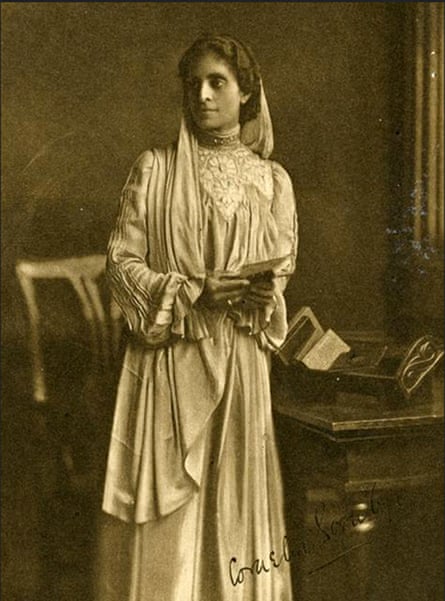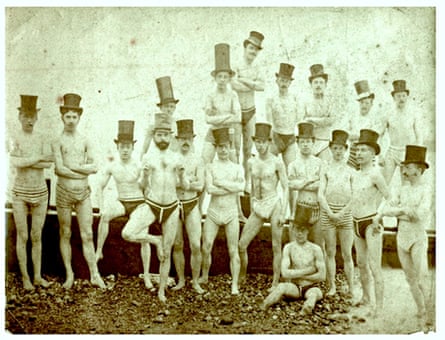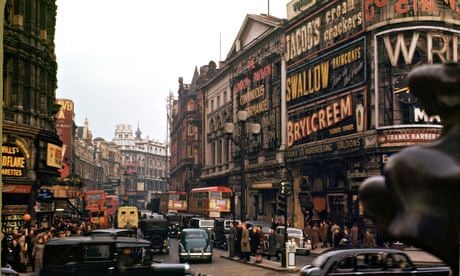It was the sign advertising Brylcreem that got me. It can be seen in one of Chalmers Butterfield's colour photographs of Piccadilly Circus in 1949. Why did it move me? Brylcreem's range of hair styling products for men is still very much with us. Personally, though, it always means the red plastic pot of the stuff my dad kept ever-ready in the bathroom of our home in the 1970s. It spoke then, and does now, of his youth in austerity Britain, skiffle-board Britain, Teddy Boy Britain.
What is nostalgia? For me it's triggered by the sense that my parents might be young people in Butterfield's deep colour vistas of the West End of London. For enthusiasts who post historic photographs on Twitter, it's more broadly scattered. These pictures reveal the wealth of photographic documents, memories and arcana that these sites have dragged into the 21st-century limelight, from an 1890s portrait of Cornelia Sorabji, India's first female advocate and the first woman to study law at Oxford University, to the building of the Hoover dam in Roosevelt's America.

History and nostalgia are not the same thing. Looking again at Piccadilly Circus in 1949, its historical evidence is crisp and unsettling. In its eerily immediate colours, you can see an underlying chromatic order. All the people are wearing brown, grey, black or a daring dark blue. Buses provide a refreshing redness, but cars mainly come in any colour you like so long as it's black. Austerity is not something the historians made up – you really can see, in this picture, the limitations of life in a postwar Britain regulated by ration books. No wonder everyone smoked (another habit of the age my parents took with them to later life). A giant cigarette in an ashtray advertises Craven "A" high above Piccadilly Circus. It's a reminder that George Orwell published Nineteen Eighty-Four in the year Butterfield took his pictures – the relentless smoker's ads resemble his totalitarian hoardings for Victory cigarettes.
Every photograph collected and tweeted by accounts such as Retronaut, @IndiaHistorypic and @HistoryinPix can be looked at like this, as a visual document of specific historical realities. Yet the fascination runs deeper. Nostalgia clings to photographs like dust to Victorian knick-knacks. It seeps out from sepia tints and Polaroid hues alike, for as the medium evolves, yesterday's invention is today's curio. The look of a 1970s snapshot is already heartbeakingly otherworldly. It is the paradoxical condition of photography to be both immediate and dated. It dates because it is so immediate. Every photo captures the light of a unique moment, a time and place dateable to the instant the shutter opened. So as soon as it is taken it starts to slip away in time – a perfectly preserved microcosm of a vanished universe.

This is the fascination of "retronauting". A photograph really is a frozen fragment of time. Not even the fastest, most gifted artists or the most sensually specific novelists have ever captured the kind of incidental realities a photograph dumbly records – the creases in the uniform of the last Napoleonic veteran, his paunch and sidelong glance and white whiskers – or the Brighton Swimming Club in 1863, naked except for their trunks and top hats. What painter would have included the ridiculous top hats? Even as we laugh, we are seeing something disarmingly real – an unfeigned revelation of Victorian habits.
Look again: the men in their top hats are caught in a pale, English light, a moment of weather, a day on planet Earth. Beyond their sartorial values, and their pallid bodies, we see the very atmosphere in which they lived. This power to preserve dead light is the principle of photography: it is shared by the first photographs of the 1830s and the cameraphone pictures being taken this very second, click, now.
So, looking at Cornelia Sorabji, it is not so much her historic achievements that move me as the fact she is there, before my eyes, as immediately as my parents or my childhood self in 1970s snaps. All gone, all lost to time and yet all captured for ever with the crystalline immediacy of photographic light. Sorabji stands in the light from a window, holding a book. Her face is half-illuminated, half in shadow. Her eyes flash with life. Yet she is standing in the 19th century. For a moment, it is possible to imagine that she is real, in her time, and we are the ghosts. Impossible ghosts from an impossible future of instant communication, looking down the time vortex through electric veils, calling out to her. What is it we are trying to say?

Comments (…)
Sign in or create your Guardian account to join the discussion